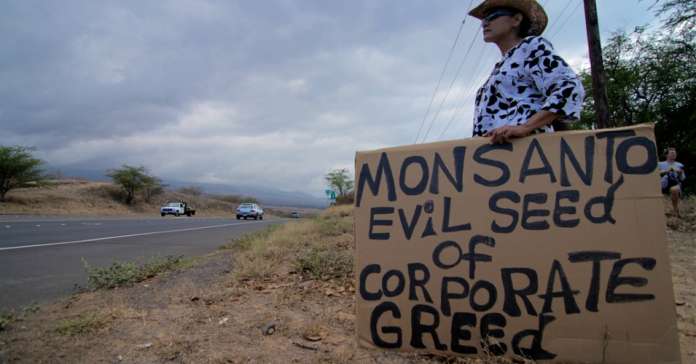26
Nov
Bayer Monsanto Skirts Felony Charge for Applying Banned Pesticide in Hawaii, by Calling on Connections at Justice Department
 (Beyond Pesticides, November 26, 2019) Bayer’s Monsanto endangered public health and the environment by knowingly storing and applying the highly hazardous and banned insecticide methyl parathion in Maui, Hawaii, according to a release from the U.S. Attorney’s office for the Central District of California. “We take this very seriously and accept full responsibility for our actions,” the company wrote on a blog post published to its website. To health and justice advocates, those words ring hollow, as widespread reports indicate that Bayer Monsanto worked behind the scenes, using high-powered connections to avoid true responsibility for its atrocious actions in the Hawaiian Islands.
(Beyond Pesticides, November 26, 2019) Bayer’s Monsanto endangered public health and the environment by knowingly storing and applying the highly hazardous and banned insecticide methyl parathion in Maui, Hawaii, according to a release from the U.S. Attorney’s office for the Central District of California. “We take this very seriously and accept full responsibility for our actions,” the company wrote on a blog post published to its website. To health and justice advocates, those words ring hollow, as widespread reports indicate that Bayer Monsanto worked behind the scenes, using high-powered connections to avoid true responsibility for its atrocious actions in the Hawaiian Islands.
According to reports from the Project on Government Oversight (POGO), the California U.S. Attorney’s office was prepared to file full felony charges against the company for its violation of federal pesticide and hazardous waste disposal laws. Bayer Monsanto, however, had hired attorney Alice S. Fisher, a former senior official in the Department of Justice, now in private practice with the law firm Latham & Watkins. At the last minute, Ms. Fisher appealed to then-Deputy Attorney General Rod Rosenstein. This led to a directive, “to resolve the Monsanto criminal case with misdemeanors only,” according to documents obtained by POGO. As POGO indicates, circumventing the long-held tradition of autonomy within U.S. attorney offices is intended to occur only “in the most unusual of circumstances.”
Methyl parathion may cause death, loss of consciousness, dizziness, confusion, headaches, difficult breathing, chest tightness, wheezing, vomiting, diarrhea, cramps, tremors, blurred vision, and sweating, according to federal health agencies. It has been found to jeopardize the survival of dozens of endangered species. The pesticide, an organophosphate insecticide, was canceled in 2012, and no products containing the chemical were permitted for use beginning January 1, 2014.
So when methyl parathion was sprayed on Maui cornfields on July 15, 2014, Bayer Monsanto knew full well that this use was prohibited. But the company went even further. The last label for the pesticide mandated a 31 day waiting period before reentering a sprayed field. Knowing all of this information, Bayer Monsanto told its employees to go to work in the sprayed fields after just one week.
Banned pesticides turn into hazardous waste. And Bayer Monsanto stored over 270 lbs of methyl parathion between the Hawaiian Islands of Maui and Molokai. This amount made the company a “Large Quantity Generator” of hazardous waste, for which it did not seek out the proper permits. The company also transported the waste, but failed to identify it as such on a shipping manifest.
In order to avoid felony charges, Bayer Monsanto have agreed to pay a total of $10.2 million. To put that number in perspective, Bayer’s third-quarter earnings were $1.15 billion. Thus, the company’s payment for endangering public health and environmental safety stands at 0.009% of its recently reported profits.
As Beyond Pesticides has reported in the past, Bayer Monsanto and other agrichemical giants have set up shop in Hawaii and are wrecking the place. These companies, both directly and through umbrella groups like Croplife America, have fought tooth and nail against any measure put forward by local elected officials aiming to safeguard the public from their toxic products. Instead of mandatory pesticide use reporting requested by local officials, agrichemical companies said they would police themselves through a “Good Neighbor Program.”
“Safety and stewardship are our top priorities and as part of this effort,” said John Purcell of Monsanto Hawaii in 2015 to Civil Beat. “We have expanded our education and outreach efforts to ensure the public that we are using the most updated farm stewardship practices to care for the health of our neighbors, communities and our land.”
This statement was made one year after the company had illegally applied methyl parathion to Maui cornfields. Despite agrichemical companies’ empty gestures, advocates have continued to push for increased protections, last year scoring a long awaited victory requiring mandatory reporting of toxic pesticide use, banning another hazardous insecticide, chlorpyrifos, for use in the state.
However, advocates may now rightly ask what is stopping agrichemical companies from continuing to illegally spray chlorpyrifos. Pesticide enforcement during the Trump Administration has been negligible, and many long-term Environmental Protection Agency (EPA) employees are demoralized. When companies can run to political appointees in the federal government to avoid real consequences for their crimes, breaking the law simply becomes the cost of doing business.
If you’re fed up with revolving door in Washington DC that lets chemical companies write and enforce their own rules, get active in your local community. Only grassroots action will bring these companies to account. Case in point, the present lawsuit was initiated because local advocates drove around cornfields taking pictures of publicly facing pesticide use report logs. A log indicating methyl parathion use was posted online, allowing others to identify the banned chemical, leading to EPA’s criminal investigation. Work to emulate these advocates: gather with friends and family, reach out to your state and local lawmakers, and fight back against toxic chemical use in your community.
All unattributed positions and opinions in this piece are those of Beyond Pesticides.
Source: Project on Government Oversight, DOJ press release










